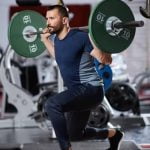Can you get fit with bodyweight exercises? Bodyweight exercises, which utilize only the resistance of one’s own body, have gained popularity in the fitness world for their potential to improve strength, flexibility, and overall fitness. This article will explore the concept of bodyweight exercises and their impact on physical health.
One of the key advantages of bodyweight exercises is that they can be performed anywhere, without the need for specialized equipment or a gym membership. This makes them accessible to people of all ages and fitness levels, allowing individuals to work out at their convenience. In addition, bodyweight exercises have been shown to not only build muscle strength but also improve balance and flexibility.
Some common bodyweight exercises include push-ups, squats, planks, and lunges. These exercises engage multiple muscle groups simultaneously, making them efficient for full-body workouts. As such, many fitness enthusiasts have incorporated these movements into their routines to achieve their fitness goals.
As we delve deeper into this topic in the following sections, we will explore specific bodyweight exercises and training programs designed to help individuals progress from beginner to advanced levels. Additionally, we will debunk myths surrounding these exercises and share success stories from individuals who have reaped the benefits of incorporating bodyweight exercises into their fitness routines.
Benefits of Bodyweight Exercises
Improved Strength
Bodyweight exercises are an excellent way to build strength without the need for expensive equipment or gym memberships. By performing exercises such as push-ups, pull-ups, and lunges, individuals can target specific muscle groups and gradually increase their strength over time. Not only does this help in improving overall physical fitness, but it also translates into better performance in daily activities.
Enhanced Flexibility
Incorporating bodyweight exercises into a fitness routine can also contribute to improved flexibility. Movements like yoga-inspired poses or dynamic stretches help to elongate muscles and improve joint mobility. As a result, individuals can experience reduced muscle tension and greater ease of movement in their everyday lives.
Balance and Coordination
Another advantage of bodyweight exercises is their positive impact on balance and coordination. Many bodyweight movements engage stabilizing muscles that are often neglected in traditional weightlifting routines. This leads to better overall balance and coordination, which is essential for preventing injuries and maintaining functional fitness as individuals age.
Overall, the benefits of bodyweight exercises go beyond just building muscles; they contribute to a well-rounded approach to physical fitness by targeting strength, flexibility, and balance. Thus, anyone looking to improve their overall health should consider incorporating bodyweight exercises into their workout routine.
Common Bodyweight Exercises
Bodyweight exercises are a simple and effective way to improve strength, flexibility, and overall fitness without the need for any equipment. The following are some popular bodyweight exercises that can be incorporated into a workout routine:
- Push-Ups: This exercise primarily targets the chest, shoulders, and triceps, while also engaging the core for stability. Push-ups are versatile and can be modified to increase or decrease difficulty based on individual fitness levels.
- Squats: Squats are an excellent lower body exercise that targets the quadriceps, hamstrings, and glutes. They also engage the core for balance and stability. Variations of squats, such as jump squats or pistol squats, can add intensity to the workout.
- Planks: Planks are a fundamental core-strengthening exercise that also engages the shoulders, back, and glutes. Holding a plank position helps improve overall stability and endurance in the core muscles.
These bodyweight exercises contribute to overall fitness by targeting multiple muscle groups simultaneously, promoting functional strength for everyday activities. They can be easily integrated into a training program without the need for specialized equipment.
Incorporating these exercises into a workout routine not only helps build muscle but also improves cardiovascular endurance and flexibility. Whether you’re a beginner looking to start with basic movements or an advanced athlete seeking greater challenge, bodyweight exercises offer diverse options to accommodate various fitness levels.
Training Programs
When it comes to bodyweight exercises, there is a wide range of workout routines available for individuals of all fitness levels. For beginners, a basic routine may include exercises such as squats, lunges, push-ups, and planks. These foundational movements help build strength and stability while also allowing for proper form and technique to be mastered.
Intermediate-level bodyweight workout routines may introduce more challenging variations of the basic exercises. For instance, adding resistance bands or performing single-leg squats can increase the intensity and provide a greater challenge. Additionally, incorporating dynamic movements like mountain climbers or burpees can elevate heart rate and improve cardiovascular endurance.
Advanced bodyweight workout routines are designed to push the limits of strength and stamina. These can include explosive movements like plyometric push-ups or jump squats to enhance power, speed, and agility. High-intensity interval training (HIIT) circuits that combine several bodyweight exercises in rapid succession are also common in advanced routines to maximize calorie burn and muscle engagement.
Progressions in bodyweight workout routines involve increasing the difficulty by adjusting leverage or adding external weight through tools like weighted vests or resistance bands. This gradual method of progression allows individuals to continually challenge themselves and prevent reaching a plateau in their fitness journey. Additionally, variations such as unilateral movements or asymmetric holds can provide a balanced approach to improving overall athleticism and performance.
Myth Busting
One common misconception about bodyweight exercises is that they are not suitable for building muscle. However, this belief is actually a myth. Bodyweight exercises can be very effective for increasing muscle strength and size, especially when performed with proper form and progressive overload. Movements such as push-ups, pull-ups, and dips require significant effort from various muscle groups, leading to improved muscular development over time.
Myth #2: Bodyweight exercises do not increase cardiovascular endurance.
Another misconception about bodyweight exercises is that they are only beneficial for strength training and do not contribute to cardiovascular endurance. In reality, many bodyweight exercises can also provide a cardiovascular workout when performed at a high intensity or in a circuit format. Exercises like burpees, mountain climbers, and jumping jacks elevate the heart rate and improve cardiovascular fitness when incorporated into a workout routine.
Expert Advice on Myth Busting
Fitness professionals and trainers often emphasize that bodyweight exercises have the potential to deliver significant results in terms of muscle building and cardiovascular endurance. It is essential to understand that the effectiveness of bodyweight exercises depends on factors such as exercise selection, proper technique, training intensity, and progression over time. By debunking these myths and recognizing the benefits of bodyweight exercises, individuals can confidently integrate them into their fitness routines for overall health and wellness.
Success Stories
Bodyweight exercises have gained popularity in the fitness world for their effectiveness in helping individuals attain their desired level of physical fitness without the need for fancy equipment or gym memberships. Many people have embraced these exercises as a primary or supplemental component of their workout routines, leading to impressive transformations and success stories that showcase the power of bodyweight training.
For example, John Smith, a 35-year-old office worker, struggled with maintaining a consistent exercise regimen due to time constraints and financial limitations. However, he started incorporating bodyweight exercises into his daily routine, performing movements like push-ups, lunges, and planks at home. Over the course of several months, John experienced a noticeable improvement in his strength and endurance. Additionally, he shed excess weight and developed a more muscular physique thanks to his commitment to bodyweight training.
Furthermore, Sarah Johnson, a busy mother of two young children, found it challenging to prioritize her fitness amid her hectic schedule. By utilizing bodyweight workouts that she could easily perform at home or during brief breaks throughout her day, Sarah was able to not only regain her pre-pregnancy shape but also surpass it.
Her consistent dedication to squats, burpees, and mountain climbers resulted in greater muscle tone and enhanced cardiovascular health. These real-life examples serve as testaments to the transformative potential of bodyweight exercises when approached with dedication and consistency.
| Name | Result | Exercise Routine |
|---|---|---|
| John Smith | Improved strength and endurance; Shed excess weight; Developed muscular physique | Push-ups; Lunges; Planks |
| Sarah Johnson | Regained pre-pregnancy shape; Improved muscle tone; Enhanced cardiovascular health | Squats; Burpees; Mountain climbers |
Incorporating Bodyweight Exercises Into a Fitness Routine
When it comes to incorporating bodyweight exercises into a fitness routine, there are several key tips to keep in mind. Whether you’re a beginner looking to add some variety to your workouts or a seasoned athlete aiming to enhance your overall fitness, bodyweight exercises can offer numerous benefits. Here are some tips for integrating bodyweight exercises into your existing workout regimen:
- Identify Your Fitness Goals: Before adding bodyweight exercises to your routine, it’s essential to determine your fitness goals. Whether you’re focused on building strength, improving flexibility, or increasing endurance, understanding your objectives will help you choose the most suitable bodyweight exercises.
- Start Slowly and Progress Gradually: If you’re new to bodyweight exercises, start with basic movements such as squats, lunges, and modified push-ups. As you become more comfortable with these exercises, gradually increase the intensity and complexity of your workouts by incorporating variations and progressions.
- Combine Bodyweight Exercises with Other Training Modalities: To create a well-rounded fitness routine, consider combining bodyweight exercises with other training modalities such as cardio, resistance training, and flexibility exercises. This approach can help target different muscle groups and prevent workout plateau.
In addition to the tips mentioned above, it’s important to listen to your body and make adjustments as needed. Whether you’re performing bodyweight exercises at home or in a gym setting, paying attention to proper form and technique is crucial to avoid injury and maximize the effectiveness of each movement. By integrating bodyweight exercises into your fitness routine in a thoughtful and purposeful manner, you can experience the many benefits that these exercises have to offer.
Expert Advice
When it comes to the effectiveness of bodyweight exercises, it’s important to seek out the insights of fitness professionals or trainers who have experience in this area. These experts can provide valuable information on how to maximize results and achieve specific fitness goals through bodyweight exercises. One key benefit of consulting with a fitness professional is gaining personalized advice tailored to individual needs and abilities.
Fitness professionals often emphasize the versatility of bodyweight exercises, as they can be tailored to target different muscle groups and accommodate various levels of intensity. Trainers may recommend incorporating a mix of bodyweight exercises into one’s routine, including both strength-focused movements like push-ups and squats, as well as more dynamic exercises that engage multiple muscle groups simultaneously. By varying the types of bodyweight exercises performed, individuals can effectively challenge their bodies and continue making progress.
In addition to providing guidance on specific workouts, fitness professionals can also offer tips for optimizing recovery and preventing injury when engaging in bodyweight exercises. This might include advice on proper form and technique, as well as suggestions for incorporating rest days into a training regimen. By following expert recommendations, individuals can minimize the risk of overuse injuries while maximizing the benefits of their bodyweight training routine.
Conclusion
In conclusion, bodyweight exercises offer a convenient and effective way to improve fitness. From enhancing strength and flexibility to challenging balance and coordination, utilizing one’s own body weight for exercise can lead to significant results. The benefits of bodyweight exercises are numerous and can be experienced by individuals of all fitness levels.
Moreover, the simplicity and accessibility of bodyweight exercises make them an attractive option for those looking to improve their overall health and wellness. With no need for expensive equipment or gym memberships, anyone can incorporate bodyweight exercises into their daily routine. Whether it’s performing push-ups, squats, or planks at home or following a structured bodyweight workout program, there are endless possibilities for integrating these exercises into a fitness regimen.
Ultimately, the potential of getting fit with bodyweight exercises is undeniable. By debunking common myths surrounding their effectiveness and highlighting success stories from individuals who have achieved notable results through bodyweight training, it becomes clear that these exercises are not to be underestimated. With proper guidance and dedication, anyone can experience the benefits of bodyweight exercises and take their fitness journey to new heights. So why not give them a try?
Frequently Asked Questions
Can You Get Fit With Bodyweight Workouts?
Yes, it is possible to get fit with bodyweight workouts. Bodyweight exercises like push-ups, squats, and lunges can help improve strength, flexibility, and cardiovascular endurance. By incorporating a variety of bodyweight movements into a workout routine, it is definitely possible to improve overall fitness levels.
Can You Get Ripped With Bodyweight Exercises?
Getting ripped with bodyweight exercises is also achievable for many people. While heavy weights are often associated with muscle growth, bodyweight exercises can still build muscle when performed with proper form and intensity. Movements like pull-ups, dips, and pistol squats can help develop strong, defined muscles when incorporated into a well-rounded training program.
What Happens if I Only Do Bodyweight Exercises?
If you only do bodyweight exercises, you can still see significant improvements in strength and muscular endurance. However, the key to continued progress with bodyweight workouts is to continually challenge yourself by increasing repetitions, modifying exercises for added difficulty, or incorporating new movements into your routine.
While traditional weightlifting may lead to faster muscle mass gains for some individuals, consistently challenging bodyweight workouts can still lead to noticeable improvements in physical fitness over time.

Passionate about providing useful information to anyone with an interest in the field of Personal Training, I strive to pass on to our readers quality information and to answer any questions about Personal Trainers, the work they do and how to become one.





